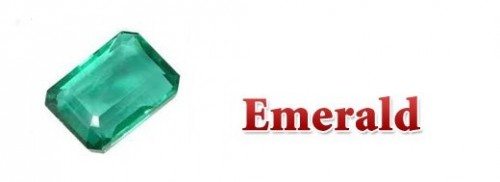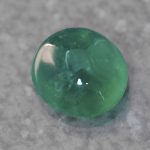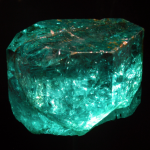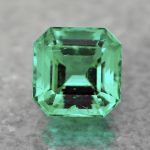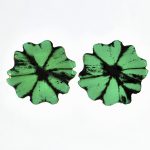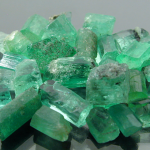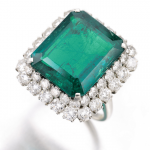Contents
Gemstone Information
Emerald is the green variety of the Beryl mineral family, characterized by the attractive green color given by Chromium impurities in the crystals. Its name derives from the France name “esmeralde” that derives from the Greek word “smaragdos” that means “green stone”.
Considered one of the most valuable gemstone, Emerald is also included in the 4 precious stones group with Ruby, Sapphire and Diamonds.
It is the chromium bearing variety of Beryl mineral family, usually show a vivid bright green, sometimes with some tint of blue or yellow color, recently in United States some gemological institute and jewelery association start to call Emerald also green Beryl crystals that contains Vanadium instead of Chromium.
In Europe green Beryl is considered another kind of gemstone from the Beryl mineral family, more close to Aquamarine than Emeralds.
Gem quality Emerald with good color and eye clean clarity are really hard to find nowadays, because Emerald is a gemstone that often show visible inclusions in the crystal and milky clarity, this inclusions make Emerald a delicate and fragile gemstone even if it has an hardness of 7.5 – 8 on the Mohs scale.
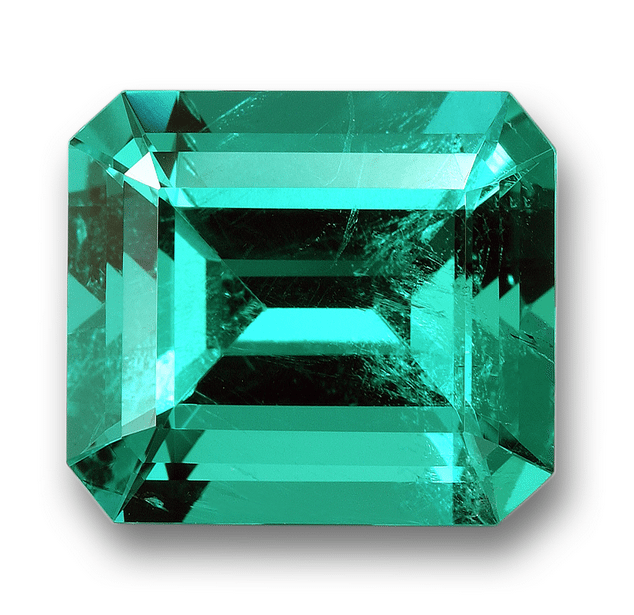
Click here to buy online natural Emerald loose gemstones.
Emerald Healing Properties
Considered an holy gemstones by the ancient people, like: Maya and Aztec, Egyptians, Romans Emerald opens and nurtures the heart and the Heart Chakra, considered a gemstone of love promotes: patience, friendship, balanced love and loyalty between partners, provide happiness, bliss, increases focus and intent.
Emerald can also activate psychic abilities and opening clairvoyance in the past it was used for protection through spells and enchantment, can give you calm and peace, active your creativity, increases mental acuity, strengthens memory.
Treatment
Duo to the scarcity to find natural Emerald with good clarity and color, often natural Emerald stones are enhanced by common treatment like impregnation with colorless oil, wax or resin to improve the clarity of the Emerald.
Some substance used to impregnate them are cedarwood oil or Opticon, with the use of these substances the cavities present on the gemstone surface will be filled improving the clarity of the Emerald gemstone.
Sometimes they are also impregnated and dyed with some green colored substances to increase the color saturation of the stone. This kind of treatment is considered invasive and must be reflected to the price of the gemstone that must be low and cheap.
Origin and gemstone source
The best variety of this gemstones, and probably the most popular are mined in Colombia, but some good quality gemstones can also comes from Brazil, Zambia, India, Afghanistan and Pakistan.
Optical Effect
Chatoyancy is the main optical effect of some rare gemstone cut into cabochon, showing a nice line of lighter green on the surface of the gemstone that moves from left to right.
Another beautiful phenomena is called Trapiche, infact Trapiche Emerald displays a six-armed, fixed star that doesn’t must be confused with asterism typical of Corundum gemstones like Ruby and Sapphire.
Trapiche Emerald display a six rays star with hexagonal pattern, caused by the black carbon impurities in the crystal that forms an attractive six rays star.
Images and photos
Click here to buy online natural Emerald loose gemstones.
Uses
This variety from the Beryl mineral family is a rare and valuable gemstone, very appreciated by the people and often used in jewelry world that usually use high endEmerald gemstones for one of kind jewel.
The most common faceted cut for Emerald is the octagonal steep cut also called emerald cut that display the beautiful green color of the gemstone and leave a windows open on the natural inclusions that often populate Emeralds, these inclusions are friendly called with the term “garden”.
Good quality natural stones can also be faceted in other popular shapes like round, oval, trilliant, cushion, square, marquise and fancy.
When the stone is translucent and not completely transparent is usually cut into cabochon.
Low quality stones (usually opaque) can also be carved into sculptures, polished into beads, rondelles, chips and polished stones.
Care and Cleaning
Natural Emerald are valuable gemstone, inserted in the top 4 most precious stones of the world, so you need to take care about your new gem, in fact it is considered a fragile gemstone, duo to its numerous internal inclusions.
Emerald gems can chipped easily if hit an object when not properly mounted into a jewel, also stone setter jewelers must take a lot of caution when setting an emerald duo to its fragility and high value.
This variety from the Beryl mineral family gemstone are also very sensitive to heat and vulnerable to chemical products, we suggest to clean your Emerald jewels with soapy water and cold water and dry it with a soft cloth.
Gems treated by oil deserve a special care because the oiling treatment is not permanent and when washing the gemstone, oil vanish and can reveal all the inclusions of the gemstone and display a different lighter color.
Also remember that it is an hard stone so can easily scratch other softer gemstones so store emerald in single packet without other gemstones.
Jewelers and stone setters must avoid to heat directly this variety from the Beryl mineral family gemstones with the torch or clean the stone with steam and ultrasonic machine.
Scam and Fraud
Emerald is a very valuable gemstone and it is really appreciate by gem market customers, so very often some scammers try to sell different stone, very close in appearance, for natural stones.
These gemstone can be easily confused with Emeralds: Tourmaline, Tsavorite garnet, Sapphire, Peridot, Dioptase, Fluorite, Phrenite, Chalcedony, Quartz, Hiddenite, Demantoid. All of these gemstones have some characteristics or color close to Emeralds.
Some common scam, reported some kind of man made doublet gemstone, composed by two or more different material glued together to resemble the natural color of Emerald.
Also man made lab grow synthetic stones can be dealt for natural Emeralds by unscrupulous gem brokers. These kind of synthetic Emerald gems are very close in appearance to the natural stone and can be really hard to distinguish the natural from the synthetic gemstone.
Also green colored glass can be sold for Emerald to unprepared buyers.
Click here to buy online natural Emerald loose gemstones.
Emerald Typical Internal Inclusions
Typical inclusions contained in the crystals, can help to identify natural stones from synthetics and simulator are: three phase inclusions, guest crystal minerals like Mika, Pyrite, Calcite, elongated needles.
Gemological Info
- Mineral family: Beryl
- Crystal: Hexagonal
- Density: 2.72
- Hardness: 7.5 – 8
- Refractive index: 1.746 – 1.755
- Color: Green (sometimes presence of tint of yellow or blue)
- Cause of color: presence of Chromium (sometimes Vanadium)
- Luster: Vitreous to resinous
- Clarity: Type 3 (often present inclusions, extremely rare to find eye clean clarity stones)
- Fluorescent: Usually none but can show some reddish color on high end gemstone
- Fracture: Conchoidal to uneven
- Cleavage: Imperfect, basal
- Durability: Delicate
Click here to buy online natural Emerald loose gemstones.

